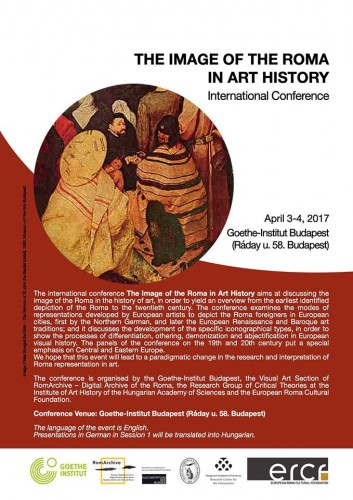Goethe-Institut Budapest (Budapest, Ráday u. 58.)
2017. 04. 03. – 04.
The conference aims at discussing the image of the Roma in the history of art, in order to yield an overview from the earliest identified depiction of the Roma to the twentieth century. The conference examines the modes of representations developed by European artists to depict the Roma foreigners in European cities, first by the Northern German, and later the European Renaissance and Baroque art traditions; and it discusses the development of the specific iconographical types, in order to show the processes of differentiation, othering, demonization and abjectification in European visual history. The panels of the conference on the 19th and 20th century put a special emphasis on Central and Eastern Europe.
We hope that this event will lead to a paradigmatic change in the research and interpretation of Roma representation in art.
The conference is organised by the Goethe-Institut Budapest, the Visual Art Section of RomArchive – Digital Archive of the Roma, the Research Group of Critical Theories at the Institute of Art History of the Hungarian Academy of Sciences and the European Roma Cultural Foundation.
The language of the event is English.
Presentations in German in Session 1 will be translated into Hungarian.
PROGRAM
APRIL 3, 2017
Session 1 – Welcome, Introduction. The Socio-Historical Context of Roma Representations
10.00–10.30 Welcome: Michael Müller-Verweyen (Goethe-Institut Budapest); Isabel Raabe (RomArchive – Digital Archive of the Roma); Gábor Pataki (Institute of Art History of the Hungarian Academy of Sciences)
10.15–10.45 Klaus-Michael Bogdal (Bielefeld University): Sehen, was wir nicht sehen. Eine kleine Sehschule gegen Vorurteile
10.45–11.15 Géza Galavics (Institute of Art History of the Hungarian Academy of Sciences): Betrachtungswechsel der Roma-Darstellungen in Ungarn und in Siebenbürgen im 17., 18. und frühen 19. Jahrhundert
11.15–11.45 Tímea Junghaus (Institute of Art History of the Hungarian Academy of Sciences, ERCF): Towards a Horizontal Art History: Three Case Studies for Writing Roma Women Into The History of Art
11.45–12.00 Discussion
(Welcome, Lecture 1 and Lecture 2 are in German, with Hungarian Translation)
12.00–13.00 Lunch
Session 2 – From the 15th Century to the Seicento
13.00–13.30 Alena Volrábová (National Gallery in Prague): Gypsies – Pagans – Turks. The Cultural–Historical Background of a Drawing
13.30–14.00 Erwin Pokorny (Academy of Fine Arts Vienna): Conjurer, Trickster, Gypsy Witch. European “Egyptians” and Magic in Early Modern Art
14.00–14.30 Peter Bell (University of Cologne): Seicento Bohème? Alterity of Gypsies and Bamboccianti in Rome
14.30–15.00 Discussion
15.00–15.15 Coffee Break
15.15–16.00 Art History, Orientalism and the Roma: the Impact of Writing the Roma into the Early Periods of Art History
Panel Discussion with the Presenters
18.00–19.30 Programme of the Goethe-Institut:
Európa hiánytalanul / Europa komplett / A Comprehensive Europe
Placing Roma Culture into the European Canon of the Arts
Round-table Discussion with Archive Specialists and Directors of Collections: Tímea Junghaus, Katalin Székely, Péter Szuhay, Erzsébet Tatai
Moderated by Dóra Hegyi
In Hungarian, with German translation
APRIL 4, 2017
Session 3 – Representations of the Roma “Others” from the 18th Century to the Early 20th Century
10.00–10.30 Júlia Papp (Institute of Art History of the Hungarian Academy of Sciences): The Instrument Hung upon the Willows in Psalm 137 and in Nicolas Lenau’s Allegorical Poem, The Three Gypsies, and Aloys Schönn’s Painting
10.30–11.00 Teri Szűcs (Eötvös Loránd University): The Old Gypsy and the Wandering Jew. Othering and Assimilating Modes of Representation (The Example of the Journal Képes Világ, 1870–1872)
11.00–11.30 Éva Kovács (Institute of Sociology of the Hungarian Academy of Sciences): Black Bodies, White Bodies. “Gypsy“ Images in the Long 19th Century in Central Europe
11.30–12.00 Csilla Martin (University of Massachusetts – Amherst): Observing the Roma through the Cultural Turn of the Avant-garde
12.00–13.00 Lunch
Session 4 – New and Old Patterns in the 20th Century
13.00–13.30 Anna Lujza Szász (Institute of Sociology of the Hungarian Academy of Sciences): Naming
13.30–14.00 Andrea Pócsik (Pázmány Péter Catholic University): Images of Resistance in Our Historicized Memory. “Kunstwollen”: Formal Experiences of Social Force in László Moholy-Nagy’s Documentaries
14.00–14.30 Dirk Suckow (Leibniz Institute for the History and Culture of Eastern Europe) ): New Colours, Old Patterns? Depicting Gypsies in Comics
14.30–15.00 Varga Krisztina (Hungarian University of Fine Arts): The Hungarian Roma Museum
15.00–15.15 Coffee Break
15.15–16.00 How Do We Continue to Differentiate the Art History Canon?
New Research Areas and Effective Strategies of Knowledge Transfer
Closing Panel Discussion with the Presenters
This is a public conference. Pre-registration is not required.
For more information contact: Teri Szucs, , or call +36302490222.
